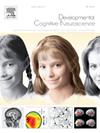Engagement of neural systems varies with level of executive function during late childhood: Evidence from a structural equation modeling approach to data from the adolescent brain cognitive development (ABCD) study
IF 4.9
2区 医学
Q1 NEUROSCIENCES
引用次数: 0
Abstract
The present study utilized structural equation models to investigate the association between brain activation and level of executive function in participants in the Adolescent Brain Cognitive Development (ABCD) study at the baseline assessment and the two-year follow-up. The results indicated that increasing levels of a latent factor reflecting activation across multiple regions of the frontoparietal network (FPN) for the contrast of a 2 vs. 0 back condition in the emotional N-back task were significantly associated with higher levels of a latent factor of common executive functioning (cEF) drawn from a variety of behavioral measures, while the opposite was true for a latent factor of activation drawn from somatomotor regions. Moreover, these relationships were specific to cEF as they held even when a latent measure of general intelligence was included. In addition, these effects were observed at each of the two distinct time points 2 years apart. cEF scores at baseline predicted FPN scores at the Year 2 follow-up after controlling for FPN scores at baseline. These results provide for the possibility that increased levels of cEF during late childhood may provide a strong substrate for continued development of the FPN and decreased reliance on somatomotor regions.
在儿童晚期,神经系统的参与随执行功能的水平而变化:来自青少年大脑认知发展(ABCD)研究数据的结构方程建模方法的证据
本研究利用结构方程模型调查了青少年大脑认知发展(ABCD)研究参与者在基线评估和两年随访中大脑激活与执行功能水平之间的关联。结果表明,在情绪N-后退任务中,反映2后退与0后退条件对比的额顶叶网络(FPN)多个区域激活的潜因子水平的增加,与从各种行为测量中得出的普通执行功能(cEF)潜因子水平的增加显著相关,而从躯体运动区域中得出的激活潜因子则相反。此外,这些关系还与 cEF 有关,因为即使将一般智力的潜在测量也包括在内,这些关系依然存在。在控制了基线时的 FPN 分数后,基线时的 cEF 分数可以预测第二年随访时的 FPN 分数。这些结果提供了一种可能性,即儿童晚期 cEF 水平的提高可能为 FPN 的持续发展和减少对躯体运动区的依赖提供了强有力的基础。
本文章由计算机程序翻译,如有差异,请以英文原文为准。
求助全文
约1分钟内获得全文
求助全文
来源期刊

Developmental Cognitive Neuroscience
NEUROSCIENCES-
CiteScore
7.60
自引率
10.60%
发文量
124
审稿时长
6-12 weeks
期刊介绍:
The journal publishes theoretical and research papers on cognitive brain development, from infancy through childhood and adolescence and into adulthood. It covers neurocognitive development and neurocognitive processing in both typical and atypical development, including social and affective aspects. Appropriate methodologies for the journal include, but are not limited to, functional neuroimaging (fMRI and MEG), electrophysiology (EEG and ERP), NIRS and transcranial magnetic stimulation, as well as other basic neuroscience approaches using cellular and animal models that directly address cognitive brain development, patient studies, case studies, post-mortem studies and pharmacological studies.
 求助内容:
求助内容: 应助结果提醒方式:
应助结果提醒方式:


